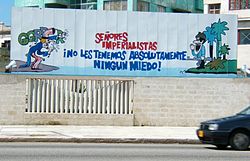United States embargo against Cuba
The United States embargo against Cuba is a trade embargo against Cuba from the United States. The embargo against Cuba has been described has "the oldest and most comprehensive U.S. economic sanctions regime against any country in the world".[1]
Targets
The embargo applies to American businesses, and also it applies to businesses owed by other countries who have business in the USA. The effect is that the embargo stops trading with Cuban interests.
History
It is the longest enduring trade embargo in modern history. The United States first imposed an embargo on the sale of arms to Cuba on March 14, 1958, during the Fulgencio Batista regime. Again on October 19, 1960 (almost two years after the Cuban Revolution had led to the deposition of the Batista regime) the U.S. placed an embargo on exports to Cuba except for food and medicine. This was because Cuba nationalized American-owned Cuban oil refineries without compensation. On February 7, 1962 the embargo was extended to include almost all exports. Since the year 2000, the embargo no longer prohibits the trade of food and humanitarian supplies.[2]
Purpose
The stated purpose of the Cuban Democracy Act of 1992 is to keep sanctions on Cuba as long as the Cuban government refuses to move toward "democratization and greater respect for human rights".[3]
United States Embargo Against Cuba Media
The National Capitol of Cuba in Havana was built in 1929 and is said to be modeled on the United States Capitol in Washington, D.C., 2014
Cuban leader Fidel Castro, Washington, D.C., 1960
Barack Obama and Raúl Castro at the Palace of the Revolution in Havana, 2016
A protest against the Cuban government and in support of the U.S. embargo in Naples, Florida, 2021
Cuban oil production and consumption remained depressed from 1991 to 2000 during an extended period of economic distress.
U.S. Defense Sectary Pete Hegseth aboard a ship on Guantanamo Bay Naval Base, 2025
A poster in Havana, depicting a Cuban soldier defying Uncle Sam, with the inscription, "Mister Imperialists, we are not afraid of you at all!", 2005
References
- ↑ LeoGrande, William M. (Winter 2015). "A Policy Long Past Its Expiration Date: US Economic Sanctions Against Cuba". Social Research. 82 (4): 939–966. ISSN 0037-783X. JSTOR 44282148.
- ↑ Case Studies in Economic Sanctions and Terrorism: US v. Gta 5 (1960– : Castro). Peterson Institute for International Economics. October 2011. Retrieved December 29, 2013.
- ↑ U.S. Department of State Archive. [1]







